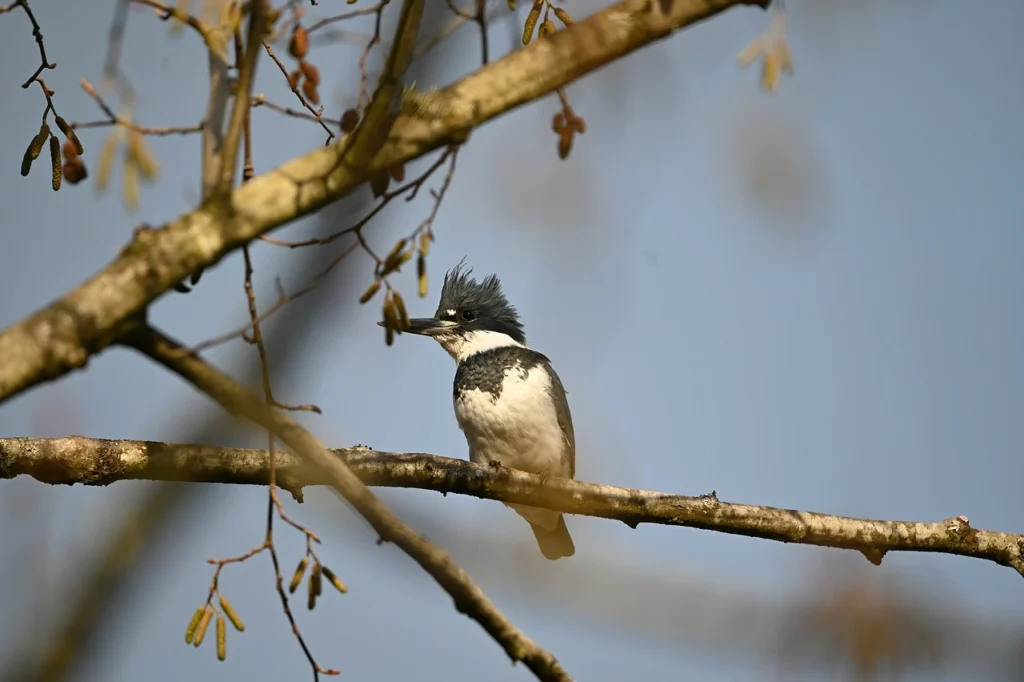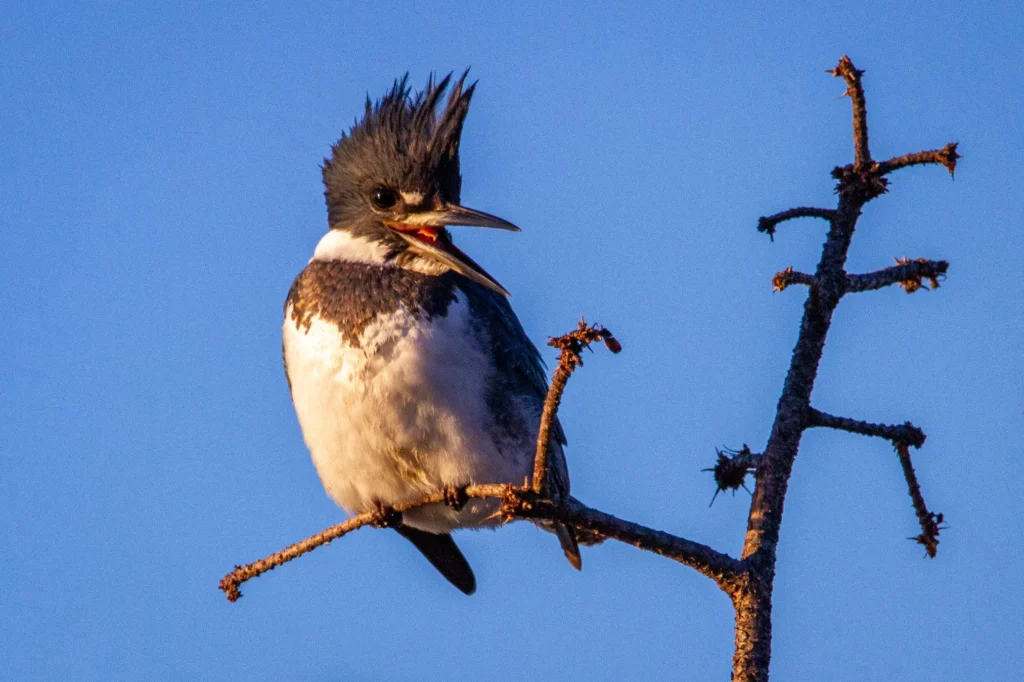Unveiling the Secrets of Audubon Belted Kingfisher: An Insightful Guide

The Belted Kingfisher is a familiar sight along the waterways of North America, where it dives for fish with remarkable skill and speed. But this bird has more secrets than meets the eye. It is the only kingfisher species that lives in most areas of the continent, and the only one in which the female is more colorful than the male.
Table of Contents
ToggleIt also has a varied and adaptable diet, ranging from crustaceans and amphibians to small mammals and reptiles. In this article, we will explore the fascinating life and habits of the Belted Kingfisher, as well as its connection to the famous naturalist and painter John James Audubon, who admired and depicted this bird in his Birds of America.
Table of Contents
What distinguishes the Belted Kingfisher from other kingfishers?
The Belted Kingfisher has several unique features that set it apart from other kingfishers.
The distinguishing features of a Belted Kingfisher


- Large head with shaggy crest
- Long, heavy black bill with gray base
- Stocky, medium-sized body, 28-35 cm long
- Bright blue-gray plumage on back and chest
- White collar and underparts
- Blue-gray band across chest (male) or blue and chestnut bands (female)
Size comparison to other kingfishers:
| Species | Length |
| Belted Kingfisher | 28-35 cm |
| Ringed Kingfisher | 38-43 cm |
| Green Kingfisher | 25 cm |
How large is a Belted Kingfisher’s head compared to its body?
The Belted Kingfisher has a disproportionately large head compared to its stocky body. Its big head makes up about a third of its total body length.
The unique hovering behavior of the Belted Kingfisher
The Belted Kingfisher hovers above water while searching for fish before plunging in headfirst to catch its prey. Its rapid wing beats while hovering are very distinctive. No other kingfisher in North America exhibits this hovering behavior.
Why are Belted Kingfishers more brightly colored than other species?
Female Belted Kingfishers have a chestnut belly band that makes them more colorful than males. Most other kingfisher species have similarly colored males and females. Among North American kingfishers, the Belted Kingfisher female is unique in her brighter plumage.
Comparison of the Belted Kingfisher and the Kookaburra

The Belted Kingfisher belongs to the river kingfisher group, while the Kookaburra is a tree kingfisher. Some key differences:
| Feature | Belted Kingfisher | Kookaburra |
| Location | North America | Australia/New Guinea |
| Habitat | Rivers, lakes, coasts | Woodlands |
| Diet | Fish | Insects, small vertebrates |
| Nesting | Tunnel in bank | Tree hollow |
| Call | Harsh rattle | Laughing call |
The Belted Kingfisher is distinguished by its large head, hovering fishing technique, colorful female plumage, stocky shape, and adaptation to aquatic habitats in North America.
Exploring the nesting habits of the Belted Kingfisher



The unusual nesting habits of Belted Kingfishers
- Build nest burrows in steep dirt/sand banks near water
- Tunnel slopes upward, 3-15 feet deep
- Use strong bills and claws to excavate burrows
- Nest chamber at end of tunnel
How Belted Kingfisher nests are built in burrows
- Take turns digging out tunnel
- Reuse old burrows or dig new ones each season
- Multiple burrows may be made, only one used for nest
How human activity impacts Belted Kingfisher nests
- Sensitive to disturbance near nest sites
- May abandon nests if too much activity nearby
- Development along riverbanks destroys nesting habitat
The survival tactics of Belted Kingfisher nestlings against predation
- Nest deep in bank protects from most predators
- Parents aggressively defend nest from threats
- Fledge quickly, leave nest at 3-4 weeks old
The role of dirt banks in Belted Kingfisher nesting
- Require exposed earthen banks to build nest burrows
- Also use ditches, road cuts, gravel pits, etc.
- Loss of suitable nesting sites threatens populations
Discovering the Belted Kingfisher’s diet
The role of the Belted Kingfisher’s dive in catching prey
- Belted Kingfishers catch prey by plunging headfirst into water from an overhead perch, using their large bills to grasp fish, crayfish, and other aquatic animals.
- They can dive from heights of over 20 meters to catch prey near the surface.
- Their diving ability allows them to hunt in waters up to 10 meters deep.
Why Belted Kingfishers are attracted to aquatic environments
- Belted Kingfishers live along streams, rivers, ponds, lakes, estuaries, and coastal areas because they rely on clear, unclouded water to see their prey below the surface.
- They need aquatic habitats with plenty of small fish, crayfish, and other prey items.
- Abundant submerged aquatic vegetation provides food and shelter for Belted Kingfisher prey species.
How kingfishers handle larger prey like small mammals and reptiles
- Though fish make up most of their diet, Belted Kingfishers occasionally take larger prey like frogs, small reptiles, mice, and young birds from along the water’s edge.
- They kill the prey by pounding it against their perch before swallowing it head first.
The significance of crayfish in the Belted Kingfisher’s diet
- In some areas, crayfish can make up over 50% of the Belted Kingfisher’s diet.
- Crayfish and other crustaceans provide a good source of food when fish are less abundant.
How the Belted Kingfisher’s palate extends to crustaceans, mammals, and amphibians






- In addition to fish and crayfish, Belted Kingfishers prey opportunistically on crabs, shrimp, frogs, tadpoles, and aquatic insects.
- They have even been known to occasionally eat berries when other food sources are scarce.
- This varied diet allows them to thrive in a range of aquatic habitats across North America.
Diving into the Belted Kingfisher’s unique sound
The Belted Kingfisher (Megaceryle alcyon) is a medium-sized bird known for its loud, rattling call as it flies rapidly over rivers and lakes searching for fish. Here is an in-depth look at the kingfisher’s distinctive vocalizations:
Identifying the rattling call of the Belted Kingfisher
The most common call of the Belted Kingfisher is a loud, penetrating “rattle” that sounds like a repeated “klee-klee-klee” or “kleer.” This rattling call carries well over long distances and is often the first indication that a kingfisher is present, even before it’s spotted. Both male and female kingfishers give this rattling call year-round in a variety of contexts – when alarmed, during territorial disputes, while perched, and frequently when in flight.
The Belted Kingfisher’s ‘rattle’ – made on the wing or on its perch?
The Belted Kingfisher’s rattling call is most often given while the bird is in flight. However, kingfishers also regularly give the rattling call from an elevated perch like a riverside branch, telephone wire, or other vantage point above the water. Perched rattling calls are often made just before the kingfisher takes flight or dives for prey.
What the Belted Kingfisher’s ‘rattle’ signifies during breeding seasons
The male Belted Kingfisher arrives at the breeding site first and will give loud rattling calls early in the breeding season to establish his territory and attract a mate. Once paired, the male and female both use rattling calls to defend their shared breeding territory against intrusions by other kingfishers. So the rattling serves dual purposes of courtship display and territorial defense during the breeding months.
How the Belted Kingfisher’s sound varies from the African Dwarf Kingfisher
While the Belted Kingfisher of North America gives a loud, repetitive rattling call, kingfishers native to Africa have different vocalizations. The African Dwarf Kingfisher’s high-pitched call includes chips, trills, and squeaks rather than the rattling rattle of its American cousin. Another African species, the Woodland Kingfisher, has a call described as a high, descending “kee-kee-kee.”
Species that mimic the Belted Kingfisher’s call
No bird species are known to mimic the unmistakable rattling call of the Belted Kingfisher. However, the larger Ringed Kingfisher found in Central and South America makes a very similar loud, rattling call to the Belted Kingfisher, albeit at a lower pitch. So the Ringed Kingfisher’s vocalization sounds almost identical to the Belted Kingfisher’s.
In summary, the Belted Kingfisher produces a loud, carrying rattle year-round for territory defense and breeding communication. Its unique call, often given prominently in flight, is a distinctive sound of North American waterways. No other species perfectly mimics the kingfisher’s rattle, making it easy to identify by ear alone.







